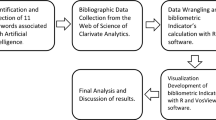Abstract
Artificial intelligence (AI), a general term that implies the imitation of information process of intelligent behavior and sense with minimal intervention, is one of the most promising research areas and has received a considerable attention with coexisting pros and cons. In order to understand the research status quo and future trends on AI technology, this work uses bibliometric analysis method to obtain this objective. By analyzing the datasets including journal article data collected from Web of Science (WOS), conference paper data retrieved from Scopus and the patent data extracted from Derwent Innovations Index (DII) in the period of 2000-2019, we primarily provide a comprehensive overview to better understand the research status of AI. Bibliometric analysis results can also shed light on the evolution and trends in AI.








Similar content being viewed by others
References
Browne M et al (2007)Near-shore swell estimation from a global wind-wave model: spectral process, linear, and artificial neural network models. Coast Eng 54(5):445–460
Carvalho MM, Fleury A, Lopes AP (2013) An overview of the literature on technology roadmapping (TRM): contributions and trends. Technol Forecast Soc Chang 80(7):1418–1437
Castelfranchi C (2013) Alan Turing’s “computing machinery and intelligence" Topoi 32(2):293–299
Chen C (2004) Searching for intellectual turning points: progressive knowledge domain visualization. Proc Natl Acad Sci USA 101(Suppl 1):5303–5310
Chen C (2006) CiteSpace II: detecting and visualizing emerging trends and transient patterns in scientific literature. J Am Soc Inform Sci Technol 57(3):359–377
Chen C et al (2009) Towards an explanatory and computational theory of scientific discovery. J Informet 3(3):191–209
Chen C (2017) Science mapping: a systematic review of the literature. J Data Inf Sci 2(2):1–40
Chen C, Leydesdorff L (2014) Patterns of connections and movements in dual-map overlays: a new method of publication portfolio analysis. J Am Soc Inf Sci 65(2):334–351
Chen C, Ibekwe-SanJuan F, Hou J (2010) The structure and dynamics of cocitation clusters: a multiple-perspective cocitation analysis. J Am Soc Inform Sci Technol 61(7):1386–1409
Cobo MJ et al (2015) 25years at Knowledge-Based Systems: A bibliometric analysis. Knowl Based Syst 80:3–13
Érdi P et al (2013) Prediction of emerging technologies based on analysis of the US patent citation network. Scientometrics 95(1):225–242
Fernandes C et al (2017) The dynamic capabilities perspective of strategic management: a co-citation analysis. Scientometrics 112(1):529–555
Fujii H, Managi S (2018) Trends and priority shifts in artificial intelligence technology invention: A global patent analysis. Econ Anal Policy 58:60–69
Hamet P, Tremblay J (2017) Artificial intelligence in medicine. Metabolism 69:S36–S40
He J et al (2019) The practical implementation of artificial intelligence technologies in medicine. Nat Med 25(1):30–36
Hinojo-Lucena F et al (2019) Artificial intelligence in higher education: a bibliometric study on its impact in the scientific literature. Educ Sci 9(1):51
Koyuncugil AS, Ozgulbas N (2012) Financial early warning system model and data mining application for risk detection. Expert Syst Appl 39(6):6238–6253
Liu J et al (2018) Artificial Intelligence in the 21st Century. IEEE Access 6:34403–34421
Marr D (1977) Artificial intelligence-a personal view. Artif Intell 9(1):37–48
Mikhaylov SJ, Esteve M, Campion A (2018) Artificial intelligence for the public sector: opportunities and challenges of cross-sector collaboration. Philos Trans Math Phys Eng Sci 376(2128):1-21
Najmi A et al (2016) Reviewing the transport domain: an evolutionary bibliometrics and network analysis. Scientometrics 110(2):843–865
Niu J et al (2016) Global research on artificial intelligence from 1990-2014: spatially-explicit bibliometric analysis. ISPRS Int J Geo Inf 5(5):66
Palaniappan R, Sundaraj K, Sundaraj S (2014) Artificial intelligence techniques used in respiratory sound analysis- a systematic review. Biomed Eng-Biomed Tech 59(1):7–18
Parkes DC (2015) Wellman, Economic reasoning and artificial intelligence. Science 349(6245):267–272
Patrício DI, Rieder R (2018) Computer vision and artificial intelligence in precision agriculture for grain crops: A systematic review. Comput Electron Agric 153:69–81
Prasad S, Tata J (2005) Publication patterns concerning the role of teams/groups in the information systems literature from 1990 to 1999. Inf Manag 42(8):1137–1148
Ramos-Rodríguez A, Ruíz-Navarro J (2004) Changes in the intellectual structure of strategic management research: a bibliometric study of theStrategic Management Journal, 1980–2000. Strateg Manag J 25(10):981–1004
Rodriguez A et al (2016) Patent clustering and outlier ranking methodologies for attributed patent citation networks for technology opportunity discovery. IEEE Trans Eng Manage 63(4):426–437
Rousseeuw PJ (1987) Silhouettes: a graphical aid to the interpretation and validation of cluster analysis. J Comput Appl Math 20:53–65
Salah K et al (2019) Blockchain for AI: review and open research challenges. IEEE Access 7:10127–10149
Sikdar S (2018) Artificial intelligence, its impact on innovation, and the Google effect. Clean Technol Environ Policy 20:1–2
Soranzo B, Nosella A, Filippini R (2016) Managing firm patents: a bibliometric investigation into the state of the art. J Eng Tech Manag 42:15–30
Tseng C, Ting P (2013) Patent analysis for technology development of artificial intelligence: a country-level comparative study. Innovation 15(4):463–475
Turing AM (1950) Computing machinery and intelligence. Mind 59(236):433–460
Wang F (2017) Artificial intelligence and intelligent transportation: driving into the 3rd axial age with ITS. IEEE Intell Transp Syst Mag 9(4):6–9
Wang M et al (2018) A novel hybrid method of forecasting crude oil prices using complex network science and artificial intelligence algorithms. Appl Energy 220:480–495
Youssef A, El-Telbany M, Zekry A (2017) The role of artificial intelligence in photo-voltaic systems design and control: a review. Renew Sustain Energy Rev 78:72–79
Zeng Y, Wang L (2017) Fei-Fei Li: Artificial intelligence is on its way to reshape the world. Natl Sci Rev 4(3):490–492
Author information
Authors and Affiliations
Corresponding author
Additional information
Publisher’s Note
Springer Nature remains neutral with regard to jurisdictional claims in published maps and institutional affiliations.
Rights and permissions
About this article
Cite this article
Gao, H., Ding, X. The research landscape on the artificial intelligence: a bibliometric analysis of recent 20 years. Multimed Tools Appl 81, 12973–13001 (2022). https://doi.org/10.1007/s11042-022-12208-4
Received:
Revised:
Accepted:
Published:
Issue Date:
DOI: https://doi.org/10.1007/s11042-022-12208-4




